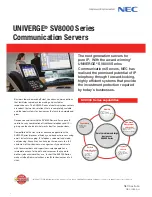
Folder, Printer, and Share Management
132
NAS 2000s Administration Guide
DFS Protocol Settings
With Distributed File System (DFS) and the Windows SMB protocol, files can be distributed
across multiple servers and appear to users as if they reside in one place on the network. A
configuration containing multiple shares is known as a virtual namespace.
Using Distributed File System (DFS), system administrators can make it easy for users to
access and manage files that are physically distributed across a network. Users do not need to
know and specify the actual physical location of files in order to access them.
For example, if documents are scattered across multiple servers in a domain, DFS can make it
appear as though the documents all resides on a single server. This eliminates the need for
users to go to multiple locations on the network to find the information.
Each DFS namespace requires a root. A DFS root is a starting point of the DFS namespace.
The root is often used to refer to the namespace as a whole. A root maps to one or more root
targets, each of which corresponds to a shared folder on a server. A root is implemented as a
shared folder on the DFS server.
Deploying DFS
A distributed file system can be implemented as a stand-alone root distributed file system or as
a domain root distributed file system. The type of a distributed file system determines which
client computers can access the distributed file system.
A stand-alone DFS root:
■
Does not use Active Directory to manage DFS
■
Cannot have more than one root on a server
■
Does not support automatic file replication using the File Replication service (FRS)
■
Is not fault tolerant and if the root fails the entire namespace will collapse.
A domain DFS root:
■
Must be hosted on a domain member server
■
Has its DFS namespace automatically published to Active Directory
■
Can have more than one root on a server
■
Supports automatic file replication through FRS
■
Supports fault tolerance through FRS
Two points of management of the DFS namespace are provided with the NAS 2000s. These
points of management are the WebUI and the Distributed File System Administration Tool
located on the local console of the NAS 2000s under Start > Programs > Administrative
Tool. See
. The WebUI is designed to provide the following functions:
■
Stand alone root management (Add, Delete)
■
Share publishing to stand alone or domain DFS
■
Default behavior for DFS share publishing
All other functions must be performed via the DFS Administration Tool. The NAS 2000s
administration guide only provides instructions on the Web UI portion of the product. The
DFS Administration Tool is complete with online help. In addition, general information on
DFS may be found at:
http://www.microsoft.com/windowsserver2003/techinfo/overview/dfs.mspx
Summary of Contents for 345646-001 - StorageWorks NAS 2000s External Storage Server
Page 16: ...About this Guide 16 NAS 2000s Administration Guide ...
Page 56: ...Storage Management Overview 56 NAS 2000s Administration Guide ...
Page 80: ...Disk Management 80 NAS 2000s Administration Guide ...
Page 110: ...User and Group Management 110 NAS 2000s Administration Guide ...
Page 146: ...Folder Printer and Share Management 146 NAS 2000s Administration Guide ...
Page 186: ...NetWare File System Management 186 NAS 2000s Administration Guide ...
















































